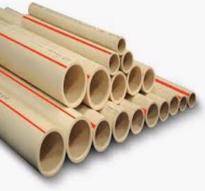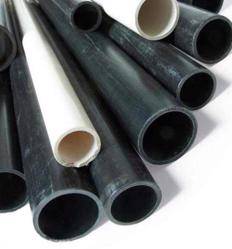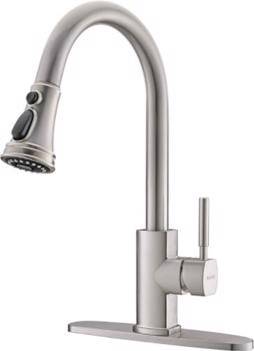Offset sinks are those whose drains are located near the edge of the sink or under the faucet rather than in the middle of the sink. Knowing this difference is key for one to install plumbing for an offset kitchen sink.
They can also come with a double bowl one bigger than the other, which is one of the advantages of offset sinks.
How to Install Plumbing for Offset Kitchen Sink
Installing the plumbing for an offset kitchen sink requires the use of PVC or ABS pipes and well-positioned faucets. Learn how to do it right in this guide and videos.
Installing plumbing for offset kitchen sinks follows the following procedure:
- Start by setting the sink in the hole on the countertop to see if it fits well.
- Take out the sink from the countertop hole and attach clips turned inward toward the sink bowl.
- Install the faucet on the hole provided on the sink.
- Around the drain, strainer applies plumbers putty and install it by pressing it firmly against the putty.
- Place and secure rubber gaskets and threaded flange underneath the sink drain by tilting it to its side.
- Using soft clothing remove the excess putty on the upper side of the side.
- If you want to install a garbage disposer, install a mounting bracket on the sink bottom using a screwdriver.
- On the edges of the kitchen basin, apply a bead of silicone sealant.
- Now you can put the sink into the countertop hole aligning it squarely.
- Rotate the metal attachments clips under the sink and make tight the nuts and screws.
- Tighten the connection of supply lines to water connections of the supply pipes and faucets making sure you don’t overtighten them.
- Following the instructions of a manufacturer install the garbage disposer.
- Now reinstall the dishwasher drain.
- To the sink drain pipe connect the disposer discharge pipe and make sure you reattach the P-trap.
- On the perimeter of the sink apply a little bit of sealant.
- Turn on the water and check where there may be leaks and connect power to the disposer.
Single normal or offset sinks, Which is better?
Offset sinks are considered far way better than single normal sinks because of the following benefits.
- When cleaning you can place anything on the bottom of the sink without blocking the drain.
- These sinks give you more space on the side of the sink without dividing the space into two like the normal sinks.
- Due to space, it gives you room for garbage disposal.
- The design makes you unique from others. Nobody wants to own exacts replica items that most people own.
- It usually comes with a grid at the bottom that makes sure nothing slips into the drain to block it.
The only disadvantage of offset sinks is that they need more complex repairs and installation and emptying are slow compared to other sinks.
Types of pipes needed to install an offset kitchen sink
The pipes mostly recommended when installing kitchen pipes are PVC and ABS pipes.

PVC pipes are more resistant to chemicals and rusts and also resist corrosion.
They are cheap and they don’t sag.
In addition, they are white in color and their fittings hold up.
At the same time, PVC pipes are extremely quiet, when it comes to noise during the draining of water. This is may come in handy when your sink gurgles due to a poor drainage system.
ABS pipes are pipes that last long.

They also resist corrosion and are also very cheap.
At the same time, ABS pipes are fitting in their color.
This is because they are black and can glue easily without a primer.
Moreover, they are stronger pipes compared to PVC pipes.
Rough plumbing offset from the center for kitchen disposal
Rough plumbing in sinks usually involves putting in place all pipes that you won’t be able to see once the sink is installed.
Only the stub-outs can be seen when these pipes are properly secured to the rooms framing and are capped until the sink is installed.
The following is the processes of putting in place the pipes that will aid in kitchen disposal:
- On the stud of the kitchen closest to the center, identify where you will put a sink drain and mark the place using a pencil.
- Keeping in mind that drain pipes maintain a minimum downslope of quarter-inch per foot towards the sewer, drill two quarter-inch holes in the floor plate and studs that can route two-inch drainpipes.
- From the larger waste line or sewer to the point you marked behind the sink run the two-inch drain pipe and tie a sanitary tee into the sewer or waste line.
- At the top of the drainage pipe install a sanitary tee. It should measure 2 by 2 by one and a half inches. The vent is put at the one and a half-inch port that should face upward. The other two-inch port should face the direction of the sink. Glue the sanitary tee into the pipe using plastic pipe cement.
- Identify the sink vent perfect route which must rise from the connection point to tie into the main vent stack. Run the vent and drill holes in the wall plates and studs to accommodate the vent.
- Using a hacksaw cut into the main stack at a point above the highest plumbing fixture in the house and install a vent tee and tie the sink vent to the main vent stack.
- Into the tee, you installed behind the sink glue a twelve-inch length of two-inch pipe and glue on the cap.
Top components of offset kitchen sink installation kits

- Faucet
A faucet is a device that delivers water from a plumbing system.
Components of a faucet may include water inlets, handles, lift rod, spout, aerator, and mixing chamber.
The body of the faucets is usually made of brass.
when you turn on the handle, the water valve opens which controls the water flow.
Faucets are either dual or single cartilage faucets.
- Tailpiece
It is a pipe that usually connects the sink strainer and runs down the tee fitting.
The tailpiece is a necessary plumbing pipe that is needed to install an offset kitchen sink. In order to be installed, it must be cut to the length that is preferred.
- P-trap
It is a plumbing fixture with a lot of functions:
- It traps debris drained from the sink.
- Prevents clog formation by debris within the plumbing system
- Prevents sewer gases from passing into the home.
It is generally made of pipe and steel.
- Plastic waste pipes and connectors
Plastic pipes are of a different variety. They are different in size and the type of plastic used to make them.
Different types of pipes may include the PVCs, ABCs, and PPs that serve different purposes and help in connections of sinks.
How to maintain an offset kitchen sink?
The best way to always maintain your offset kitchen sink is by cleaning and sanitizing it.
Other ways of maintaining your kitchen sink include:
- Protecting your sink from scratches and stains that may become permanent.
- Controlling the formation of rust in your kitchen by using the WD-40 to wipe the rusty spots.
- Keeping your sink drain clog-free.
How to set offset faucet kitchen sink
The most crucial thing when setting a faucet is ensuring that it directs water where you need it.
It also directs water to avoid crowding or near the backsplash preventing you from turning the handle.

It can be located anywhere around the sink considering these factors:
- The sink is over hanged by the spot completely.
- The spot is swiveling freely
- The operation of the handle will not be interfered with.
- Nothing will prevent you from hooking the faucet to the water supply.
If you are installing a two-hole faucet or a three-hole faucet make sure the holes are oriented in a line to the sink.
Single handled faucets require one hole while two holes are required in bridge-style faucets and three holes on traditional –double handle faucets,
How to hook up offset drain pipe kitchen sink
PVC pipes and elbows are required to create a proper angle that allows pipes to run from the sink drain to the main waste pipe of your home when setting offset drains.
Offset sinks with two drains require a lot of work to hook up compared to single drain offsets.
The following is the hook-up process:
- Start by inserting the tailpiece nut washer at the bottom of the drain basket strainer. Slide the slip nut to the end of the tailpiece and screw it until its tight onto the threaded bottom of the threaded housing. Add the second tailpiece to the other sink drain.
- Screw the nut at the bottom of each tailpiece to attach a one and half inch trap adapter
- At the farthest point away from the side of drain outlets insert the end of the 90-degree elbow onto the sink drain adapter.
- On the other sink drain with the side opening pointing towards the bottom of the 90-degree elbow insert the top of the sanitary tee onto the adapter.
- Cut a section of a two-inch diameter pipe after measuring the distance between the elbow and the tee.
- On the bottom of the sanitary tee insert a riser and connect it to the P-trap and drain outlet.
- Cement with an even layer of PVC cement the two-inch pipe sections, the interior of the elbow, sanitary connector, exterior of the trap adapter and all areas you primed and then connect the pipe to the trap adapter.
- Cement the rest of P-trap pipe components to each other to continue assembling the sink drain.

How to offset a kitchen sink drain with the garbage disposal?
The drain stub-out should always come farther from the wall than the garbage disposal drain. The P-trap should loop backward to meet the garbage disposal tailpiece.
You can make the drain stub-out shorter and provide space for the garbage disposal. This is part of the plumbing requirements when you install an offset kitchen sink
The garbage disposal must be above the drain stub with a height that is determined by the installation in your kitchen which ranges from 1 inch to 5 inches.
Watch this video for more


As a homeowner, I am specifically keen on home improvement. I am passionate about homes, yards, and home improvement. I blog on home ideas and reviews on solutions that make homes better.

